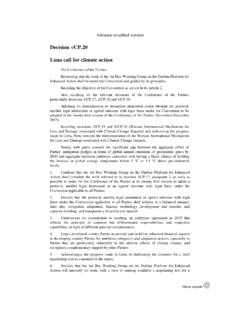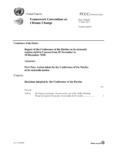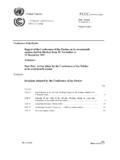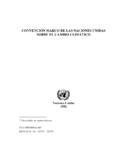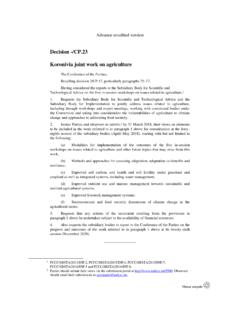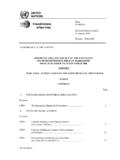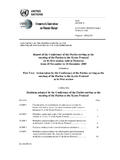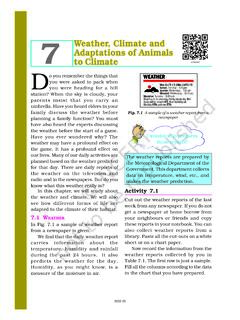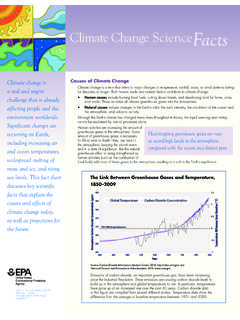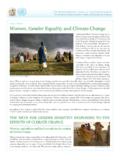Transcription of Climate Resilience - UNFCCC
1 Climate ACTION PATHWAY Climate Resilience Executive Summary 2020 2 VISION STATEMENT By 2050 we all live in a warmer world where all regions, countries, cities, businesses communities and individuals THRIVE in the face of multiple risks, uncertainty and threats posed by Climate change This vision of Climate Resilience is to be achieved through three interdependent outcomes: Resilient people and livelihoods When we live in a world where people most vulnerable to Climate risks, especially those living in least developed countries and small island developing States, are resilient, prosper and thrive.
2 Actions are taken so all benefit from early warning systems; decent, secure and green jobs; resilient value chains; social protection; and getting finance to where it matters: local communities. This helps achieve Climate justice and a just transition for all with no one left behind. Resilient Businesses and Economies Where all Climate risks are fully understood by all businesses, investors and society. Actions are taken to manage these risks across and within sectors, with particular focus on cities, infrastructure, services (including energy, transport and industry), agriculture and food, water and natural ecosystems, and ocean and coastal systems.
3 This includes delivering access to Climate risk insurance for small, medium and large enterprises, and helping ensure trillions of US dollars in future investments are Climate risk-informed and deliver social, environmental and economic impacts. Resilient Environmental Systems Where nature, with its mosaic of terrestrial and marine ecosystems, is the first line of defence against Climate risks of extreme events and disasters as well as long-term changes in Climate . This means biodiversity and the natural ecosystems are protected to ensure the world has nutritious food, clean air, fresh water, fertile soils and pollination services.
4 This is paramount if we are to secure resilient and sustainable development for human and planetary health and wealth and learn lessons from the COVID-19 pandemic. This vision puts a focus on people as agents of change to act now and tomorrow to transform systems for an equitable, low-carbon, resilient and sustainable future. This will involve everyone, especially women, youth, indigenous peoples and those living with disabilities. It means helping shape COVID-19 recovery investments to build a low-carbon and resilient future.
5 This vision recognizes that building Climate Resilience requires mitigation and adaptation actions that must be combined to tackle the current and future impacts of Climate change. 3 SYSTEMS TRANSFORMATION SUMMARY Urgent and coherent Climate risk management measures, accompanied by mitigation actions, must be adopted by all public, private and community actors in order to achieve a resilient world. Only with these actions will a transition to an inclusive, resilient and sustainable world be possible.
6 This is an imperative for the most vulnerable people, many of whom are living in least developed countries and small island developing states. Action needs to focus on sectors that are most impacted and which are crucial to people s lives, economies and the future of the planet. This includes the agriculture and food sectors, cities, infrastructure and services (energy, industry and transport), water and natural ecosystems, and ocean and coastal systems. While it is important to focus on building the adaptation and Resilience capacities1 of all public, private and community actors, this is insufficient as there is no shared narrative and clear taxonomy of Climate risk management interventions.
7 Instead we have myriad interventions, tools, solutions, initiatives and partnerships that are often promoted as single magic bullets to build Climate Resilience against multiple or single Climate risks. This pathway, and the sector pathways, aims to address this by presenting a common and simple narrative on Climate Resilience that can drive the political and financial engagement needed to tackle the unfolding Climate emergency. This narrative has been developed by the Marrakech Partnership for Global Climate Action s Climate Resilience Steps to build Climate Resilience Building Climate Resilience involves all actors (governments, communities and businesses) having the capacity to anticipate Climate risks and hazards, absorb shocks and stresses, and reshape and transform development pathways in the longer term.
8 We propose six steps that sectors and actors need to take in developing Climate Resilience : 1. Awareness-raising and advocacy Be clear that the future will not resemble the past; base this on science and examine different scenarios ( and higher) and their impacts. 2. Carry out Climate risk assessments at national, local (city/region), sectoral or organizational level and use a systems approach. 3. Develop and implement appropriate actions and interventions. 4. Mobilize resources Build capacity and scale up actions.
9 5. Monitor and track progress. 6. Share knowledge, experiences and solutions. Types of interventions to build Climate Resilience We have combined disaster risk reduction and management (including emergency preparedness and response) and Climate change adaptation approaches to develop a suite of interventions to address Climate risks and impacts across and within sectors. This suite of Climate risk management 4 interventions or measures essential to drive Climate Resilience efforts and investments by all actors includes: Climate risk and vulnerability assessments, disclosure and monitoring Early warning systems and early action Preparedness: contingency plans/emergency response Climate risk governance and capacity-building Nature-based solutions used to reduce risks across sectors Climate -proofing infrastructure and services Risk transfer.
10 Insurance and social protection Sharing of knowledge and best practices on Climate risk management Volume, quality and access of public and private finance Climate risk management interventions needed to build Climate Resilience across sectors and systems are presented in the forthcoming Climate Resilience Action Table. More specific interventions are given in the sectoral action tables for land use (especially food and agriculture); human settlements (especially the built environment); energy, industry and transport; ocean and coastal areas; and water.


